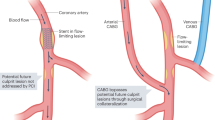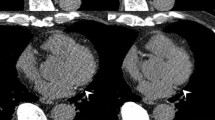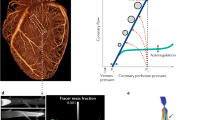Abstract
Imaging has had an important role in cardiovascular disease over the past decade, with the increasing reliance on imaging outcomes as surrogates for clinical end points. Clinical trials now show a trend towards the use of functional, rather than anatomical, imaging modalities. Use of these powerful tools needs to be optimized in the design of cardiovascular trials. In the future, imaging modalities will be fundamental to research and drug development and an increased emphasis will be placed on the relationship between the results of imaging studies and clinical outcomes.
Key Points
-
A wide spectrum of imaging techniques can be used in the management of patients with cardiovascular disease; these modalities may be invasive or noninvasive, and have anatomical or functional targets
-
The role of imaging in cardiovascular clinical trials has grown tremendously
-
Imaging studies have shed light on mechanistic processes and their use is prominent in the early phases of drug development and safety assessment
-
Imaging findings are viable surrogate markers for cardiovascular end points and, in future clinical trials, increased use of imaging modalities could decrease financial costs
This is a preview of subscription content, access via your institution
Access options
Subscribe to this journal
Receive 12 print issues and online access
$209.00 per year
only $17.42 per issue
Buy this article
- Purchase on Springer Link
- Instant access to full article PDF
Prices may be subject to local taxes which are calculated during checkout


Similar content being viewed by others
Change history
01 November 2009
A Correction to this paper has been published: https://doi.org/10.1038/nrcardio.2009.186
References
US Department of Health & Human Services. National Institutes of Health Research Portfolio Online Reporting Tool (RePORT): reports, data and analyses of NIH research activities. Estimates of Funding for Various Research, Condition, and Disease Categories (RCDC) [online], (2009).
Davies, M. J. Acute coronary thrombosis—the role of plaque disruption and its initiation and prevention. Eur. Heart J. 16 (Suppl. L), 3–7 (1995).
Davies, M. J. Stability and instability: two faces of coronary atherosclerosis. The Paul Dudley White Lecture 1995. Circulation 94, 2013–2020 (1996).
Waters, D., Craven, T. E. & Lesperance, J. Prognostic significance of progression of coronary atherosclerosis. Circulation 87, 1067–1075 (1993).
Berry, C. et al. Comparison of intravascular ultrasound and quantitative coronary angiography for the assessment of coronary artery disease progression. Circulation 115, 1851–1857 (2007).
O'Leary, D. H. et al. Carotid-artery intima and media thickness as a risk factor for myocardial infarction and stroke in older adults. Cardiovascular Health Study Collaborative Research Group. N. Engl. J. Med. 340, 14–22 (1999).
Bots, M. L. et al. Common carotid intima–media thickness and risk of stroke and myocardial infarction: the Rotterdam Study. Circulation 96, 1432–1437 (1997).
Hodis, H. N. et al. The role of carotid arterial intima–media thickness in predicting clinical coronary events. Ann. Intern. Med. 128, 262–269 (1998).
Tang, T. Y. et al. Correlation of carotid atheromatous plaque inflammation with biomechanical stress: utility of USPIO enhanced MR imaging and finite element analysis. Atherosclerosis 196, 879–887 (2008).
Trivedi, R. A. et al. In vivo detection of macrophages in human carotid atheroma: temporal dependence of ultrasmall superparamagnetic particles of iron oxide-enhanced MRI. Stroke 35, 1631–1635 (2004).
Amirbekian, V. et al. Detecting and assessing macrophages in vivo to evaluate atherosclerosis noninvasively using molecular MRI. Proc. Natl Acad. Sci. USA 104, 961–966 (2007).
Hoffmann, U. et al. Noninvasive assessment of plaque morphology and composition in culprit and stable lesions in acute coronary syndrome and stable lesions in stable angina by multidetector computed tomography. J. Am. Coll. Cardiol. 47, 1655–1662 (2006).
Hyafil, F. et al. Noninvasive detection of macrophages using a nanoparticulate contrast agent for computed tomography. Nat. Med. 13, 636–641 (2007).
Wayhs, R. et al. High coronary artery calcium scores pose an extremely elevated risk for hard events. J. Am. Coll. Cardiol. 39, 225–230 (2002).
Pohle, K. et al. Characterization of non-calcified coronary atherosclerotic plaque by multi-detector row CT: comparison to IVUS. Atherosclerosis 190, 174–180 (2007).
Carrascosa, P. M. et al. Characterization of coronary atherosclerotic plaques by multidetector computed tomography. Am. J. Cardiol. 97, 598–602 (2006).
Chen, B. X. et al. Neointimal coverage of bare-metal and sirolimus-eluting stents evaluated with optical coherence tomography. Heart 94, 566–570 (2008).
Wang, J. et al. Near-infrared spectroscopic characterization of human advanced atherosclerotic plaques. J. Am. Coll. Cardiol. 39, 1305–1313 (2002).
Moreno, P. et al. Detection of lipid pool, thin fibrous cap, and inflammatory cells in human aortic atherosclerotic plaques by near-infrared spectroscopy. Circulation 105, 923–927 (2002).
Weber, W. A. & Figlin, R. Monitoring cancer treatment with PET/CT: does it make a difference? J. Nucl. Med. 48 (Suppl. 1), 36S–44S (2007).
Ishino, S. et al. 99Tc-annexin A5 for noninvasive characterization of atherosclerotic lesions: imaging and histological studies in myocardial infarction-prone Watanabe heritable hyperlipidemic rabbits. Eur. J. Nucl. Med. Mol. Imaging 34, 889–899 (2007).
Johnson, L. L. et al. 99Tc-annexin V imaging for in vivo detection of atherosclerotic lesions in porcine coronary arteries. J. Nucl. Med. 46, 1186–1193 (2005).
Isobe, S. et al. Noninvasive imaging of atherosclerotic lesions in apolipoprotein E-deficient and low-density-lipoprotein receptor-deficient mice with annexin A5. J. Nucl. Med. 47, 1497–1505 (2006).
Kietselaer, B. L. et al. Noninvasive detection of plaque instability with use of radiolabeled annexin A5 in patients with carotid-artery atherosclerosis. N. Engl. J. Med. 350, 1472–1473 (2004).
Virmani, R., Ladich, E. R., Burke, A. P. & Kolodgie, F. D. Histopathology of carotid atherosclerotic disease. Neurosurgery 59 (Suppl. 3), S219–S227 (2006).
Yusuf, S. et al. Effects of an angiotensin-converting-enzyme inhibitor, ramipril, on cardiovascular events in high-risk patients. The Heart Outcomes Prevention Evaluation Study Investigators. N. Engl. J. Med. 342, 145–153 (2000).
Lonn, E. et al. Effects of ramipril and vitamin E on atherosclerosis: the study to evaluate carotid ultrasound changes in patients treated with ramipril and vitamin E (SECURE). Circulation 103, 919–925 (2001).
Crouse, J. R. 3rd, Craven, T. E., Hagaman, A. P. & Bond, M. G. Association of coronary disease with segment-specific intimal–medial thickening of the extracranial carotid artery. Circulation 92, 1141–1147 (1995).
Espeland, M. A. et al. Reliability of longitudinal ultrasonographic measurements of carotid intimal–medial thicknesses. Asymptomatic Carotid Artery Progression Study Research Group. Stroke 27, 480–485 (1996).
Yusuf, S. et al. Vitamin E supplementation and cardiovascular events in high-risk patients. N. Engl. J. Med. 342, 154–160 (2000).
Chen, Z. et al. Troglitazone inhibits atherosclerosis in apolipoprotein E-knockout mice: pleiotropic effects on CD36 expression and HDL. Arterioscler. Thromb. Vasc. Biol. 21, 372–377 (2001).
Brown, J. D. & Plutzky, J. Peroxisome proliferator activated receptors as transcriptional nodal points and therapeutic targets. Circulation 115, 518–533 (2007).
Dormandy, J. A. et al. Secondary prevention of macrovascular events in patients with type 2 diabetes in the PROactive Study (Prospective Pioglitazone Clinical Trial in Macrovascular Events): a randomised controlled trial. Lancet 366, 1279–1289 (2005).
Nissen, S. E. et al. Comparison of pioglitazone vs glimepiride on progression of coronary atherosclerosis in patients with type 2 diabetes: the PERISCOPE randomized controlled trial. JAMA 299, 1561–1573 (2008).
Langenfeld, M. R. et al. Pioglitazone decreases carotid intima–media thickness independently of glycemic control in patients with type 2 diabetes mellitus: results from a controlled randomized study. Circulation 111, 2525–2531 (2005).
Ratner, R. E. et al. Assessment on the prevention of progression by rosiglitazone on atherosclerosis in diabetes patients with cardiovascular history (APPROACH): study design and baseline characteristics. Am. Heart J. 156, 1074–1079 (2008).
Cannon, C. P. et al. Intensive versus moderate lipid lowering with statins after acute coronary syndromes. N. Engl. J. Med. 350, 1495–1504 (2004).
Nissen, S. E. et al. Effect of intensive compared with moderate lipid-lowering therapy on progression of coronary atherosclerosis: a randomized controlled trial. JAMA 291, 1071–1080 (2004).
Taylor, A. J. et al. ARBITER: Arterial Biology for the Investigation of the Treatment Effects of Reducing Cholesterol: a randomized trial comparing the effects of atorvastatin and pravastatin on carotid intima medial thickness. Circulation 106, 2055–2060 (2002).
Ridker, P. M. et al. Rosuvastatin to prevent vascular events in men and women with elevated C-reactive protein. N. Engl. J. Med. 359, 2195–2207 (2008).
Nissen, S. E. et al. Effect of very high-intensity statin therapy on regression of coronary atherosclerosis: the ASTEROID trial. JAMA 295, 1556–1565 (2006).
Crouse, J. R. 3rd et al. Effect of rosuvastatin on progression of carotid intima–media thickness in low-risk individuals with subclinical atherosclerosis: the METEOR Trial. JAMA 297, 1344–1353 (2007).
Kastelein, J. J. et al. Simvastatin with or without ezetimibe in familial hypercholesterolemia. N. Engl. J. Med. 358, 1431–1443 (2008).
Tardif, J. C. et al. Effects of the acyl coenzyme A:cholesterol acyltransferase inhibitor avasimibe on human atherosclerotic lesions. Circulation 110, 3372–3377 (2004).
Nissen, S. E. et al. Effect of ACAT inhibition on the progression of coronary atherosclerosis. N. Engl. J. Med. 354, 1253–1263 (2006).
Meuwese, M. C. et al. ACAT inhibition and progression of carotid atherosclerosis in patients with familial hypercholesterolemia: the CAPTIVATE randomized trial. JAMA 301, 1131–1139 (2009).
Kastelein, J. J. et al. Effect of torcetrapib on carotid atherosclerosis in familial hypercholesterolemia. N. Engl. J. Med. 356, 1620–1630 (2007).
Barter, P. J. et al. Effects of torcetrapib in patients at high risk for coronary events. N. Engl. J. Med. 357, 2109–2122 (2007).
Nissen, S. E. et al. Effect of torcetrapib on the progression of coronary atherosclerosis. N. Engl. J. Med. 356, 1304–1316 (2007).
A study of the effect of RO4607381 on atherosclerotic plaque in patients with coronary heart disease ClinicalTrials.gov: a service of the US National Institutes of Health [online], (2009).
Tardif, J. C. et al. Effects of reconstituted high-density lipoprotein infusions on coronary atherosclerosis: a randomized controlled trial. JAMA 297, 1675–1682 (2007).
Nissen, S. E. et al. Effect of recombinant ApoA-IMilano on coronary atherosclerosis in patients with acute coronary syndromes: a randomized controlled trial. JAMA 290, 2292–2300 (2003).
Niacin plus statin to prevent vascular events. ClinicalTrials.gov: a service of the US National Institutes of Health [online]. (2009).
Farkouh, M. E. et al. Design of the Future Revascularization Evaluation in Patients With Diabetes Mellitus: Optimal Management of Multivessel Disease (FREEDOM) Trial. Am. Heart J. 155, 215–223 (2008).
Thoenes, M. et al. The effects of extended-release niacin on carotid intimal media thickness, endothelial function and inflammatory markers in patients with the metabolic syndrome. Int. J. Clin. Pract. 61, 1942–1948 (2007).
Brown, B. G. et al. Simvastatin and niacin, antioxidant vitamins, or the combination for the prevention of coronary disease. N. Engl. J. Med. 345, 1583–1592 (2001).
Taylor, A. J. et al. Arterial Biology for the Investigation of the Treatment Effects of Reducing Cholesterol (ARBITER) 2. Circulation 110, 3512–3517 (2004).
Taylor, A. J. et al. The effect of 24 months of combination statin and extended-release niacin on carotid intima–media thickness: ARBITER 3. Curr. Med. Res. Opin. 22, 2243–2250 (2006).
Author information
Authors and Affiliations
Corresponding author
Ethics declarations
Competing interests
The authors declare no competing financial interests.
Rights and permissions
About this article
Cite this article
Razzouk, L., Farkouh, M. Imaging outcomes in cardiovascular clinical trials. Nat Rev Cardiol 6, 524–531 (2009). https://doi.org/10.1038/nrcardio.2009.104
Published:
Issue Date:
DOI: https://doi.org/10.1038/nrcardio.2009.104
This article is cited by
-
Correction: Imaging outcomes in cardiovascular clinical trials
Nature Reviews Cardiology (2009)



